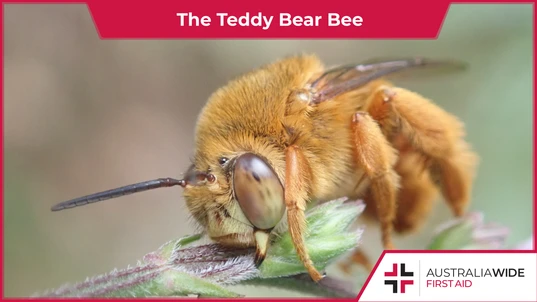First Aid for Teddy Bear Bee Stings

Bites and Stings

Teddy bear bees are solitary creatures that build underground nests in soft soil across Australia. Despite their cute name, they can give a painful sting on par with that of the Fire ant.
Despite their cute name, Teddy bear bees can a give painful sting on par with that of the Fire ant. These bees are also unique in that they are solitary creatures, with females building individual nests in soft soil. Their nests can be found in a variety of regions throughout Australia, and they play an important role in pollinating our flowering plants. In this article, we will help you become better acquainted with the Teddy bear bee and provide information on what to do if you are stung by one. We also cover bee stings in our first aid courses: To book a course near you, head to the Locations page on our website.Appearance
The Teddy bear bee (Amegilla bombiformis) has the following identifying characteristics:- Generally range in length from 15-20 mm
- Typically more rotund than European honey bees
- Their body and legs are covered in golden brown hairs, save for several dark, hairless bands on their abdomen
- As these bees age, the hair on their thorax falls out and they develop a bald spot
- Their wings are dark brown
- Their antennae are of medium length
Distribution and habitat
These Australian native bees are widely distributed throughout the country, except for Tasmania. Unlike European honeybees, Australia's common domestic honeybee, Teddy bear bees are solitary creatures. Females build small burrows for themselves in soft soil near creek banks or underneath houses. In saying that, Teddy bear bees may build nests close to one another in ideal locations.Ecology
Teddy bear bees, or Golden haired mortar bees, play an important role in pollinating Australia's flowering plants, as they are buzz pollinators. Buzz pollinators create vibrations that cause tiny capsules in certain plant species to open and release pollen. Unfortunately, ongoing land clearing for human development represents a major threat to native bee habitats. To help combat this problem, you can plant nectar rich flowers in your backyard to create a native bee-friendly sanctuary.First aid for a bee sting
To teat a Teddy bear bee sting:- Calm and reassure the casualty
- If possible, remove the stinger quickly with a blunt, straight-edged object, such as a fingernail
- Wash the sting site with soap and water before applying a cold compress
- You can also apply hydrocortisone cream to reduce swelling and itching
- Monitor the casualty for signs of an allergic reaction and follow the anaphylaxis treatment guide as necessary
Final thoughts
The Teddy bear bee is a plump, furry creature that plays an important role in pollinating Australia's flowering plants. Like most bees, they have a painful sting that can be treated with a cold compress and hydrocortisone cream. To learn more about treating bee stings, enrol in one of our first aid courses: Head to the Locations page on our website to book a course near you today.
Originally published at
https://www.australiawidefirstaid.com.au/resources/teddy-bear-bee
as part of the Australia Wide First Aid Articles Library









